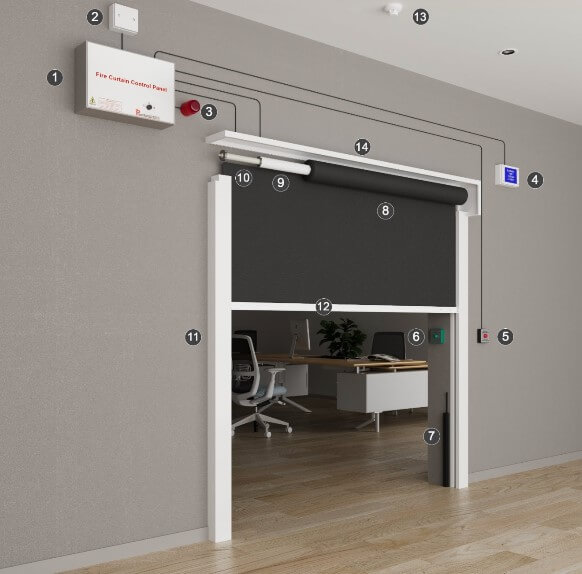Fire curtains are barriers that have been specifically designed to resist fire and are made of materials that are heat-resistant and do not emit toxic gases when burned. The installation of the curtains, which are equipped with fire alarms and sensors, is done in the ceiling or wall cavity, and they remain out of sight. On receiving a fire alarm or sensor signal, the device it is activated on comes down on its own to separate the space and prevent fire and smoke from entering other areas.
Such appliances are capable of holding off the attack of the fire for long periods of time, usually 60 to 120 minutes, thus they provide safe evacuation of the people in the building and the arrival of fire brigades without any rush.
Why Architects and Engineers Prefer Fire Curtains
1. Design Freedom Without Compromise
Usually, fire doors and shutters of the traditional are the main factors that limit the creative freedom of the designer. However, fire curtains are compatible with any kind of space, hence they can be used in open spaces, glass atriums, and multi-level lobbies without disturbing the visual flow. Besides, they do not sacrifice natural light and transparency which are the two most important things in contemporary architecture.
2. Lightweight Yet Robust
The components of a fire curtain such as reinforced glass fiber or a specially treated textile are very light but still strong. Because of this, there is practically no limitation on the kind of building that can have a fire curtain where metal barriers or shutters cannot be installed due to the heavy load that the structure can only bear to a certain extent.
3. Energy and Space Efficiency
Fire curtains are very space-saving since when they are not in use, all you see is a small housing unit above the ceiling where the fabric is rolled. This is what makes them perfect for retrofitting and energy-efficient projects where the space left for further use is very small.
Advancements in Fire Curtain Technology
One of the major changes in fire curtains is that they have become more intelligent and flexible to changes. Thus, automated systems are now able to accept inputs from building management platforms and hence offer real-time monitoring, system testing, and remote diagnostics. They also contain a few transparent ones, which allow partial view even when they have been deployed – thus, helping in the orientation of the space and rescue operations.
Besides this, the materials they are made of are also changing. Enhanced kinds of paint can tolerate very high temperatures and still be flexible and reliable for a very long time. In addition to this, modern fire curtains address the ever-increasing environmental concerns through the use of eco-friendly manufacturing processes
Conclusion
Basically, A1S Group is a combination of three worlds – innovation, reliability, and architectural fire safety elegance. With its decades-long experience and its pledge to always move forward, the firm is the guarantee of every single installation being conducted to the highest levels of safety standards and at the same time, safeguarding the design.

